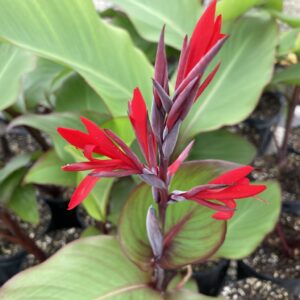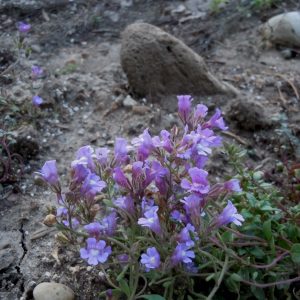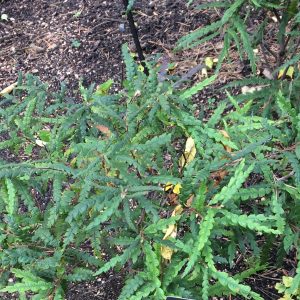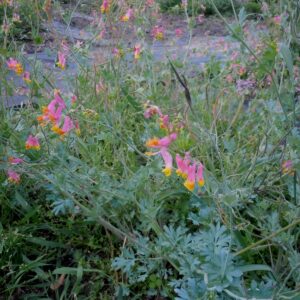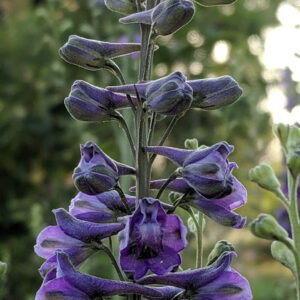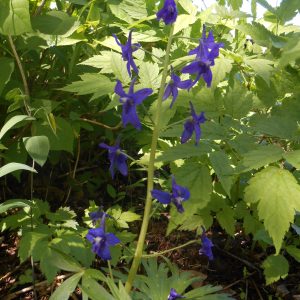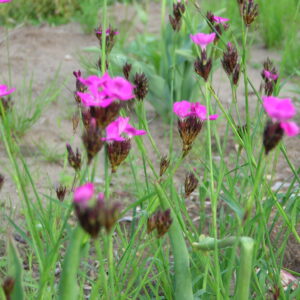Plants for Hummingbirds
Showing 9–16 of 82 results
-
Canna edulis Indian shot, Arrowroot Z 7-10, Tender Perennial
Several shoots of red, tube-like flowers atop a tall stalk , taller than its banana plant-like, broad, waxy, oval foliage, green with purple toward the top. Flower all summer.
Several shoots of red, tube-like flowers atop a tall stalk , taller than its banana plant-like, broad, waxy, oval foliage, green with purple toward the top. Flower all summer.
Size: 8’ x 3’ spreading
Care: sun in moist to moist well-drained
Native: Andes of South America, and the West Indies
Wildlife Value: attracts bees, hummingbirds and butterflies.
Size: Primarily grown as a root crop to eat, Roast or boil root like a potato. Root is source of arrowroot used as thickener.Edulis means edible.
Carbon dating of tubers shown grown more than 3500 years ago.In colder Zones, lift and overwinter indoors.
**LISTED AS OUT OF STOCK BECAUSE WE DO NOT SHIP THIS ITEM. IT IS AVAILABLE FOR PURCHASE AT OUR RETAIL LOCATION.
-
Chaenorhinum glareosum Dwarf snapdragon Z 5-9
Rare plant. Spires of tiny purple to blue trumpets with yellow throats spring, summer & fall. Love this itsy plant.
Rare plant. Spires of tiny purple to blue trumpets with yellow throats spring, summer & fall. Love this itsy plant.
Size: 4” x 9-12” semi-trailing cushion
Care: sun to part shade in well-drained soil
Native: Spain
Wildlife Value: Attracts bees, butterflies and birds.1st described in 1838. Chaenorhinum means “honey lotus” in Greek.
-
Comptonia peregrina Sweet Fern Z 2-6 SHRUB
Grown for it’s fern like leaves, this small shrub flowers in spring with insignificant yellow flowers followed by brown nutlets. Foliage is fragrant when crushed.
Grown for its fern like leaves, this small shrub flowers in spring with insignificant yellow flowers followed by brown nutlets. Foliage is fragrant when crushed.
LIMITED QUANTITES AVAILABLE. ONE PER CUSTOMER PLEASE.
Size: 2-5’ x 4’ spreading
Care: sun to part shade in moist, well-drained to well-drained soil. Prefers acidic, but will grow in other types of soil as well. Drought and salt tolerant.
Native: Eastern North America, Wisconsin native
Wildlife Value: Attracts bees, butterflies, & birds. Larval host plant for many moths, including Io moth, several Sphinx moth species, and the Anise Swallowtail butterfly. Deer resistant. Nitrogen fixer.Genus name honors Henry Compton (1632-1713), Bishop of London and patron of botany. Many Native Americans (Algonquin, Cherokee, Chippewa, Delaware, Menominee, Potawatomi) used this plant for a wide variety of purposes: crushed leaves inhaled for headache. Leaf infusions for round worms, fevers, beverage, blood purifier, blisters, clear mucus from lungs, bladder inflammation, rash from poison ivy, swelling, flux, stomach cramps, itch. Fragrant leaves- burned or crushed for incense in ceremony, perfume; decoction for childbirth, tonic. Other: sprinkle on medicine to poison enemy, prevent blueberries from spoiling, leaves in fire to make smudge to ward off mosquitoes. Oneida made a tea.
Collected for botany before 1753. Grown at America’s 1st botanic garden, Elgin Botanic Garden 1811.**LISTED AS OUT OF STOCK BECAUSE WE DO NOT SHIP THIS ITEM. IT IS AVAILABLE FOR PURCHASE AT OUR RETAIL LOCATION.
-
Corydalis sempervirens syn. Capnoides sempervirens, Fumitory, Rock harlequin RESEEDING SHORT-LIVED PERENNIAL
Pink tube-shaped flowers with flaring yellow ends bloom from spring to summer
RESEEDING SHORT-LIVED PERENNIAL
Pink tube-shaped flowers with flaring yellow ends bloom from spring to summer
Size: 10-12” x 10-12”
Care: Sun to part shade in moist well drained soil
Native: from Nova Scotia west to Alaska, south to North Carolina, Wisconsin nativeCorydalis is Greek for “lark” korydalos, referring to the shape of flower resembling a lark’s spur. First described and named (name now changed) in 1753. Pressed specimen in Emily Dickinson’s herbarium.
-
Corylus americana American Hazelnut, Filbert Z 4-9
In spring, showy male flowers on 2-3" long catkins. Female flowers appear in small, reddish catkins grow into half inch long, egg-shaped edible nuts. Fall color ranges from orange, rose, purplish red, yellow and green.
In spring, showy male flowers on 2-3″ long catkins. Female flowers appear in small, reddish catkins grow into half inch long, egg-shaped edible nuts. Fall color ranges from orange, rose, purplish red, yellow and green.
Size: 10-16’ x 8-1’
Care: sun in any soil
Native: E. North America including Wisconsin
Wildlife Value: Exceptionally high value to wildlife. Pheasant, Quail, Turkey, Grouse, Turkey & Blue Jay and small animals eat the nuts. Pollen source for bees, host to many caterpillars both butterflies and moths. Branches make good nesting sites for songbirds. Black walnut tolerant.Described by Thomas Walter in 1788. Food for several Native American tribes. Medicinal for Cherokee, Iroquois, Menominee, Meskwaki and Ojibwa, to remedy hives, fever, headaches, pain of baby’s teething, hay fever and induce vomiting.
**LISTED AS OUT OF STOCK BECAUSE WE DO NOT SHIP THIS ITEM. IT IS AVAILABLE FOR PURCHASE AT OUR RETAIL LOCATION.
-
Delphinium exaltatum Tall Larkspur, American larkspur Z 4-8
Fabulous, not because of a big flower-head, but because it grows everywhere with no special care, graceful lavender or purple spikes of trumpets on tall stems in July to August and beyond.
Fabulous, not because of a big flower-head, but because it grows everywhere with no special care, graceful lavender or purple spikes of trumpets on tall stems in July to August and beyond.
Size: 3-4' x 9"
Care: sun to part shade in moist well-drained soil. Withstands winds, no staking needed. Not fussy. Let the seeds drop & you’ll get babies.
Native: Pennsylvania to No. Carolina west to Ohio & Alabama
Wildlife Value: attract hummingbirdsDelphinium, named by Dioscorides, is Greek for “dolphin” due to the resemblance of the flower shape. According to William Aiton (1731-1793), early director at Kew Royal Garden, Quaker nurseryman and explorer John Bartram (1699-1777) sent it to England. London’s Chelsea Physic gardener Philip Miller grew it in 1758. Jefferson planted this at Monticello in the NW quarter of the outer border in March 1811.
-
Delphinium tricorne Dwarf larkspur, Spring larkspur Z 4-8
Spring ephemeral of blue delphinium elf-cap spikes. Substitute these for tulips, a favorite food of deer and rabbits
OUT OF STOCK – Available to order in Spring only
Spring ephemeral of blue delphinium elf-cap spikes. Substitute these for tulips, a favorite food of deer and rabbits
Size: 18-24” – 6-9”
Care: sun to shade in moist well-drained to moist soil
Native: Pennsylvania to Iowa, south to Alabama and Oklahoma and states in between
Wildlife Value: food for hummingbirds and butterflies; deer & rabbit resistant.Collected by André Michaux c. 1800. Cherokee used this for heart ailments and reported that it makes cows intoxicated and they die. The name tricorne comes from the 3-cornered shape of its seeds, like the shape of colonial hats with brims turned up on three sides. This is breathtakingly beautiful but slow to grow. It is also an ephemeral and dies back after going to seed so mark it or have a good memory where it is so you don’t dig into it planting something else. It comes back in spring.
-
Dianthus carthusianorum Clusterhead PinkDianthus carthusianorum Carthusian pink, Clusterhead pink Z 5-9
Deep reddish pink flowers atop wiry stems from June until frost
Rosy carmine pink flowers atop wiry stems from June until frost
Size: 16" x 8"
Care: sun in moist well-drained soil.
Native: Central and southern Europe
Wildlife Value: attracts hummingbirds. Deer resistant.The common name “pink” is from “pinct” referring to the jagged edge of the petals. The word “pink” referring to the color, came from the fact that most of the Dianthus are pink. This species may have come into gardens with the Carthusian monks in the 1100’s.

